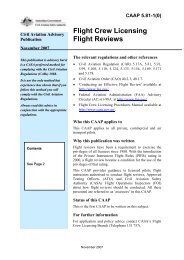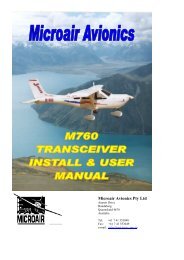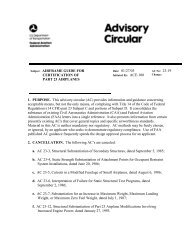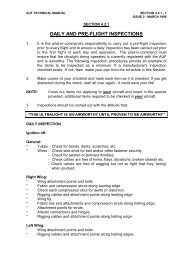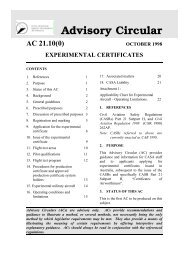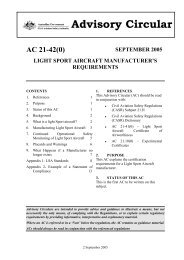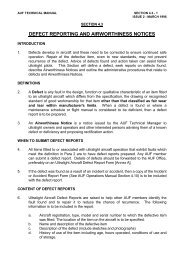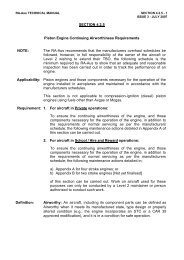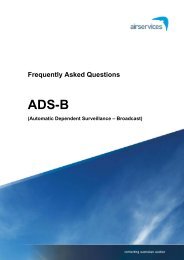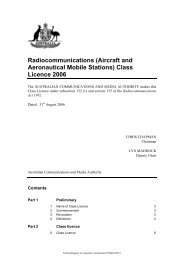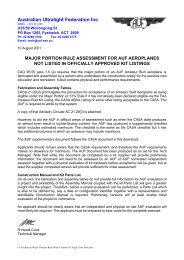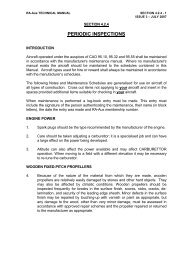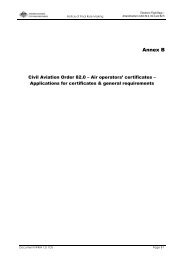Review of midair collisions involving general aviation ... - Fly Safe!
Review of midair collisions involving general aviation ... - Fly Safe!
Review of midair collisions involving general aviation ... - Fly Safe!
You also want an ePaper? Increase the reach of your titles
YUMPU automatically turns print PDFs into web optimized ePapers that Google loves.
• All occurred in visual meteorological conditions. Only six occurred at night and<br />
four occurred at dusk. Bright sun was on the only commonly sighted factor related<br />
to weather.<br />
• About 88 per cent <strong>of</strong> pilots involved in <strong>midair</strong> <strong>collisions</strong> do not see the other<br />
aircraft in time to avoid a collision.<br />
• Most <strong>midair</strong> <strong>collisions</strong> involve low closing speeds, as one aircraft usually strikes<br />
the other from behind, above or from a quartering angle.<br />
• Most <strong>midair</strong> <strong>collisions</strong> occur near airports, especially airports without a control<br />
tower. Midair <strong>collisions</strong> at high altitudes are rare events.<br />
• A common factor in <strong>midair</strong> <strong>collisions</strong> was pilots using inappropriate entries into<br />
the circuit and failing to use radios at non-towered airports.<br />
• The 329 <strong>midair</strong> <strong>collisions</strong> indicate that see-and-avoid has inherent limitations as a<br />
tactic or strategy for avoiding <strong>midair</strong> <strong>collisions</strong>.<br />
Morris 20 also conducted a review <strong>of</strong> <strong>midair</strong> <strong>collisions</strong> in the US from 1991 to 2000.<br />
His review was based on 158 <strong>collisions</strong>. 21 Morris’s findings for the 158 <strong>collisions</strong><br />
included:<br />
• The sky condition was clear for 67 per cent <strong>of</strong> the <strong>collisions</strong> and broken/overcast<br />
for 33 per cent.<br />
• Seventy-six per cent were ‘airport involved’. Exactly what was meant by his term<br />
was not clear. Over the same period, the ATSB classified 60 per cent as occurring<br />
in or near the circuit area (that is, within 5 NM <strong>of</strong> the airport).<br />
• Fifty-nine per cent (92) were classified as occurring in the traffic pattern, with just<br />
under half <strong>of</strong> these occurring on final approach. 22<br />
• Of the 92 <strong>collisions</strong> classified as occurring in the traffic pattern, 27 per cent<br />
involved a failure to use the radio, 22 per cent involved a failure to use<br />
procedures, 18 per cent involved air traffic control errors and nine per cent<br />
involved sun glare.<br />
• In 88 per cent <strong>of</strong> the <strong>collisions</strong>, one or both aircraft were manoeuvring at the time<br />
<strong>of</strong> collision.<br />
• Most <strong>of</strong> the <strong>collisions</strong> in the traffic pattern involved the two aircraft colliding head<br />
to tail or at an acute angle. About half <strong>of</strong> the <strong>collisions</strong> away from the traffic<br />
pattern involved the two aircraft colliding head to tail or at an acute angle, with<br />
the other half occurring at an oblique angle or head to head.<br />
20 C. C. Morris, Current analysis <strong>of</strong> hazard factors in US civil <strong>aviation</strong> <strong>midair</strong> <strong>collisions</strong>, 1991-2000, paper presented at the<br />
Association for Public Policy Analysis and Management, November 2003.<br />
21 The ATSB review examined only 151 <strong>collisions</strong> for this period . The ATSB review excluded three <strong>collisions</strong> that were not<br />
accidents, two glider-glider <strong>collisions</strong> and two balloon-balloon <strong>collisions</strong>.<br />
22 The ATSB review classified 47 per cent (81) as occurring in the circuit. The reason for the different classifications was not<br />
clear, although Morris’s review probably had a broader definition <strong>of</strong> what constituted a traffic pattern. The ATSB review used<br />
the same criteria as it used for classifying the Australian occurrences.<br />
15



